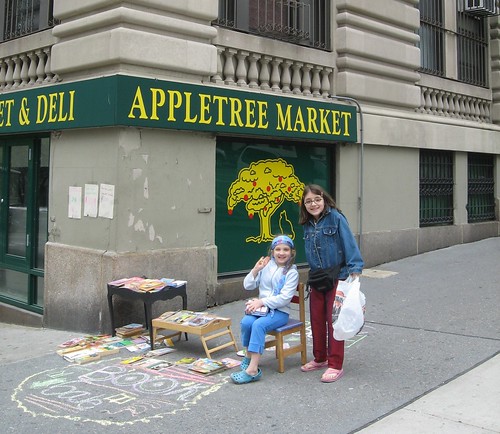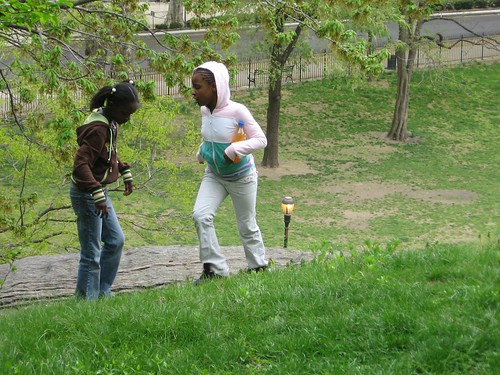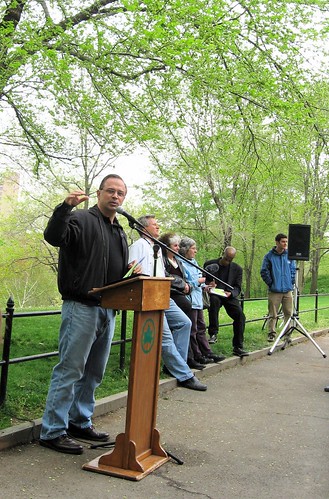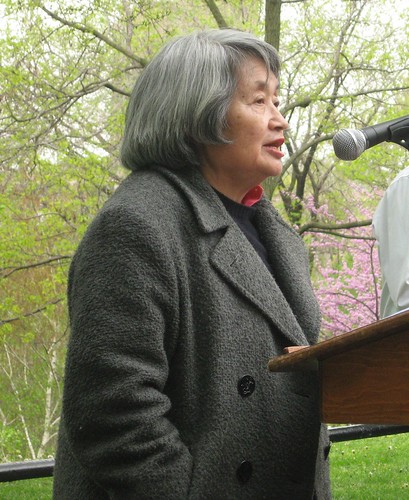Columbia 68 and the World (5)
Sunday morning, Jan and I bade farewell to Middle Village and drove with Peter back to Morningside Heights. He found a parking space near our former apartment at 423 W. 120 St. in front of which sat two little girls selling some of their old books–a nice selection of Berenstain’s Bears to bring home for the grandchildren.

We passed huge construction cranes filling the airspace at the corner of Broadway and on to Earl Hall, the venue for the morning’s programs. Entering the upstairs rotunda we heard the last part of an extraordinary soprano saxophone rendition of “Amazing Grace” closing the memorial celebration for those of the strikers who had died in the last 40 years.

As I stepped inside I remembered this space 38 years ago, filled with paintings, sculptures, photographs, a great inflatable transparent tepee and 180 or so students participating in the three day final-exam festival of performance and ritual that concluded my Pastoral and Utopia class and my University teaching career before we headed for the end of the road in Canada. The poster for that event had been framed by a large Omega, suggesting its apocalyptic overtones but also signifying Ohm, the logo of “The Resistance,” an organization for civil disobedience opposing the draft. In the open-mike session that followed the memorial, Peter spoke earnestly about that group, which preceded and outlasted the Columbia strike–of its assistance to those fleeing the country or going underground, of its sit-ins at draft boards, of its members who went to jail for long periods, of its commitment to non-violence, of the predicament of young males at the time personally oppressed not by sexism but by militarism.
Then it was time for the last of the conference’s beautifully sequenced events–a ceremony at the site of the unbuilt gym in Morningside Park. We walked there with Mike Taylor, a fellow ex-Resistance member and head of a substance abuse clinic at St. Luke’s Hospital who now lives in 423 W. 120th. I’d remembered the park as a littered, graffitied, overgrown and threatening place one tried to stay away from, this being part of the rationale for Columbia’s appropriation of it. But on this overcast Spring day it radiated splendor. Mature trees of many hardwood species were fresh leaved or in full blossom. Jonquils and hyacinths bloomed among glistening rock outcrops. Children of all complexions played tag on the paths and stairways and shrieked in the playgrounds below.

In the fenced-off dog run, pets and owners shared fragrance. Across the the street from the facing row of Harlem brownstones, a man performed acrobatic calisthenics while fans cheered at a softball game.

The dramatic cliffs, long staircases, winding paths and large trees brought back memories of Fort Tryon and Inwood Parks, where I could go to escape the dark tenement in Northern Manhattan in which I lived as a kid. Approaching the site we heard the sound of a waterfall plunging over the ragged scar of rock blasted before the fence was torn down by protestors, and we saw the large pond below filling the space flattened by bulldozers they’d sat in front of. Above us on the slope rose the apse of the Cathedral of St. John the Divine, topped with a trumpeting angel. In the distance the towers of Manhattan, behind them bridges and the low hills of Queens.

The first speaker at the podium set up on the asphalt path was Brad Taylor, President of the Friends of Morningside Park, a neighborhood association devoted to the preservation and improvement of the Park. He gave a brief description of the association whose motto is “Our Common Ground,” told of the recent success of their efforts to give the Park Landmark designation to protect it forever from development, and expressed gratitude to the audience for our efforts forty years ago that made their triumph possible. The community spirit, public participation, and financial largesse of this organization seemed a model of the “new urbanism” celebrated as an alternative to the blight and sprawl afflicting the whole country. But I wondered what proportion of its members lived in the luxury high rise condos on the Cathedral property, and I worried about what those protesting the gentrification of Harlem the day before would have to say about this idyllic picture.
Taylor introduced a man in a leather jacket and jeans who’d been sitting casually on the railing as Adrian Benepe, Parks Commissioner of the City of New York. Benepe welcomed us with another tribute to our actions forty years ago. He remembered as a young boy, his father, a Columbia professor, coming home bloody from police beatings in the melee after the bust. Benepe offered a tribute to the man responsible for the restoration of the scar left when Columbia abandoned construction, Marshall Brown, a master gardener who designed the plan and recruited volunteers to plant and tend the vegetation that surrounded us. To commemorate the revival of the park, we’d be planting a weeping cherry tree to symbolize the idea of people coming together in healing and reconciliation.

Benepe had hoped to introduce Thomas Hoving, colorful former director of the Metropolitan Museum and New York Parks Commissioner in 1966 and 1967 when the gym controversy heated up, but he was not well enough to attend. Instead Benape read passages from Hoving’s autobiography stating his “vow to bring a halt to this disgusting project” and describing his encounters with the loathed Grayson Kirk, who was sure that with Wall Street and City officials behind him there was no way it could be stopped.
Benepe’s folksy self-confidence and his enthusiasm for urban green space as the center of community excited my admiration, but once again, a challenge to authority created second thoughts. While he spoke, a dignified man with a short white beard handed out half-page leaflets accusing Benape of complicity with “The Destruction of Thousands of Trees that has Occurred in New York Under the Bloomberg Administration, mostly in the interest of privatizing public space.” Then I remembered that at the open mike an hour earlier, Joel Kupferman, with the Environmental Justice Committee of the National Lawyers Guild, had accused Benepe of being the one who’s refused to allow anti-war rallies in Central Park and who’s responsible for the installation of artificial turf in dozens of city parks.
The next speaker was Sam White, one of the SAS students who occupied Hamilton Hall. He recalled growing up in Harlem, where he still resides, and loving the park as a child. He and his friends regarded it as theirs not Columbia’s, and when he “went up the hill,” as the first one in his family to attend college, he was devastated by watching the fence erected and the bulldozers going to work. He praised the “creative obstruction” of the takeover and the partnership the students felt with the members of the Harlem community who also came up the hill to provide them food and protection.

The final speaker was Suki Ports, a woman diminutive in stature but powerful in voice and carriage. Not affiliated with the university, she was an early Morningside Park activist and the organizer of this commemorative event. Well before the student demonstrations, she had sat in front of a bulldozer to keep it from knocking down trees at the gym site “that it took three of us to put our arms around.” The many years of battle that produced this outcome, she said, has led to a healing of black and white.

A little internet research while I was writing this revealed that after the gym construction was stopped, the mess wasn’t cleaned up for twenty years, largely due to disputes among different community organizations, including the West Harlem Community Organization, Friends of Morningside Park, and the group led by Suki.
After Suki’s speech, we all clambered down near the top of the waterfall where the weeping cherry stood ready for planting. As the audience clapped, four shovel fulls of dirt were thrown on its roots by Suki, Adrian, Sam and Brad.

Note: To access more photos, a slideshow and larger versions of the ones included here, go to this flickrpage.
